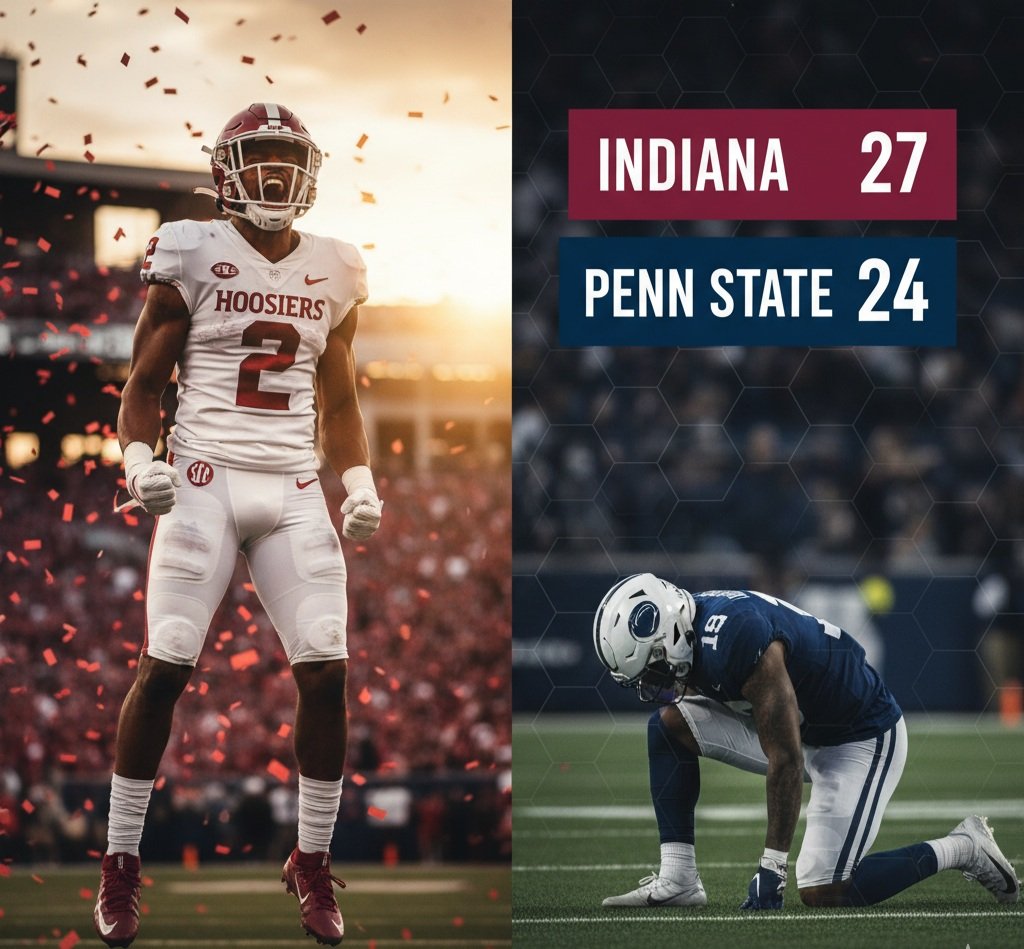By Amaranth Sportline — The Voice of Great Champions
The final tick of the clock hadn’t yet faded when Indiana Hoosiers sealed a gutsy 27-24 triumph over Penn State Nittany Lions, but the key to the victory was mapped much earlier: Indiana’s red-zone prowess clashed with Penn State’s late-game coverage flaws, and the result was decisive.
Setting the Scene
Playing at Beaver Stadium, in the cauldron of Penn State’s home turf, Indiana entered with a mission — to take control of the critical area between the 20-yard line and the goal post. The red zone is where games are won or lost, and this matchup highlighted that fact.
While the Nittany Lions have often shown flashes of offense and defense, their numbers in the red zone have been quietly underwhelming. They’ve allowed scores on 86.2 % of red-zone trips, ranking among the weaker units nationally. Meanwhile, Indiana’s offense regularly capitalizes—scoring on 89.8 % of its own red-zone opportunities.
Why the Red-Zone Battle Mattered
Red-zone efficiency isn’t glamorous—but it is absolute. When you make the zone count, you force your opponent’s defense into damage control. Indiana did exactly that:
Early in the game Indiana broke into the red zone and cashed in a score swiftly—setting the tone.
Penn State’s red-zone defense bent, but didn’t always break, giving Indiana sustained drives and control of field position.
An extended Indiana drive into the red zone late in the game positioned them for the winning touchdown. This sequence didn’t just reflect a single play—they dominated the critical geography and the game-ending moment.
Penn State’s late defensive positioning and adjustments couldn’t live with Indiana’s red-zone offense under pressure.
The Hoosiers’ dominance wasn’t flashy with numbers you’ll usually see on highlight reels—it was methodical. Move the chains, find the red zone, make the stop or score. Indiana’s strength inside the 20 amplified every other advantage they held.
Turning Points Revealed
1. Third quarter hold by Indiana’s defense. By keeping Penn State out of the end zone during a red-zone trip, Indiana forced a field goal instead of a touchdown—making each subsequent trip more valuable.
2. The late-game drive. With the game hanging in the balance and the red zone looming, Indiana orchestrated a precise march that leveraged their efficiency in tight space and pressure situations. Their ability to score under duress sealed the win.
3. Penn State’s breakdown in coverage inside the 20. Despite earlier success moving down the field, the Nittany Lions’ red-zone defense collapsed at the worst possible moment—yielding a touchdown that flipped the win probability.
4. Indiana’s offense converting when it mattered. High red-zone conversion rates are helpful—but converting under pressure and late in tight games is what separates good from great. Indiana showed both.
The Bigger Picture
This win speaks volumes for Indiana’s trajectory. Their red-zone offense is elite; their red-zone defense is stingy. When you marry those inside advantages with smart situational football, close road wins become less about luck and more about execution.
For Penn State, the snapshot is sobering. The underlying metrics—allowing scores on 86% of red-zone opportunities and struggling with third-down defense—point to systemic issues.
In a conference where margins are thin and reputations are fragile, mastering the red zone is a competitive edge. Indiana holds that edge now. Penn State must answer whether they can close the gaps before their next high-stakes moments arrive.
What to Watch Next
Indiana’s next test: Can the Hoosiers sustain this red-zone dominance away from home and in hostile environments? Teams will now game-plan specifically for their red-zone strength.
Penn State’s red-zone adjustment: Will they tighten their coverage, reduce opponent red-zone trips, and force more field goals instead of touchdowns?
Late-game coverage schemes: As Indiana executed its finish, Penn State’s response late didn’t hold. Future foes will examine those moments and try to exploit them.
Final Take
The final score may read 27-24, but hidden beneath the numbers is the cold logic of red-zone warfare: Indiana’s offense exploited the most valuable real estate on the field, and their defense bent when it needed to but didn’t break. Penn State went toe-to-toe but ultimately failed to impose its will inside the 20.
In the end, the game-winning drive was more than a collection of plays—it was the culmination of a strategic advantage that Indiana built and leveraged when it mattered most. That red-zone edge is the mark of a program trending upward—and on this night, it delivered the difference between a good win and a statement victory.

